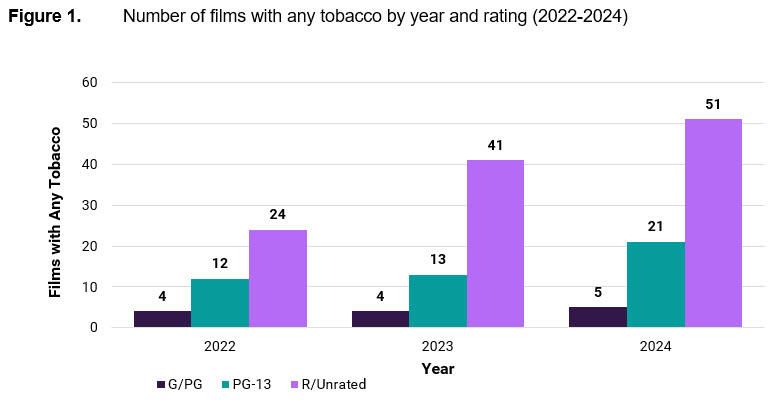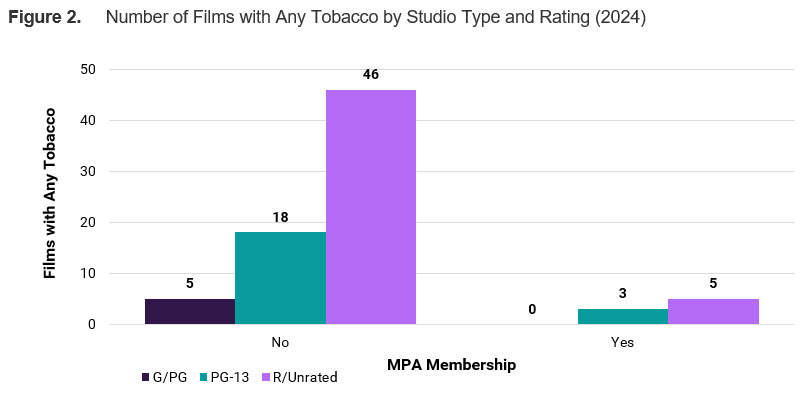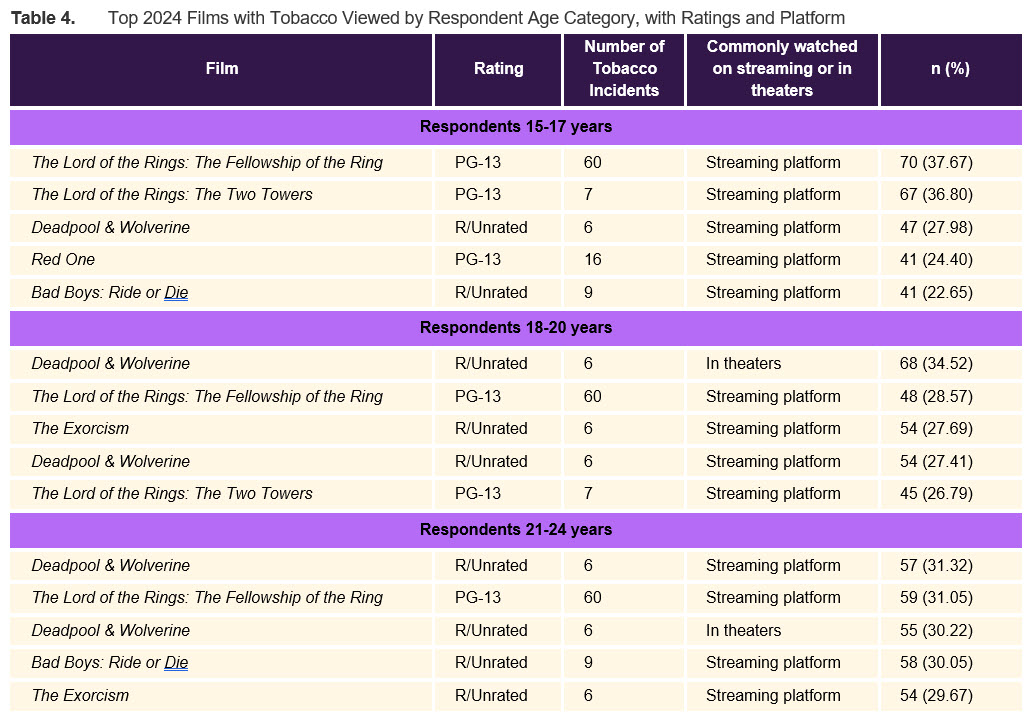Tobacco in Films: 2024
This report examines the presence of tobacco imagery in the top 2024 box office films, highlighting an increase in tobacco use portrayals compared to 2023. Tobacco imagery was present in 51% (77 of 152) of top films released in 2024, marking an increase from 2023 when 41% (58 of 141) contained tobacco. Alarmingly, the number of tobacco incidents rose by 43%, with a total of 2,858 incidents, up from 1,989 in 2023.
Among films rated appropriate for youth (G, PG, PG-13), approximately 34% (26 of 77) contained tobacco imagery, continuing a concerning trend of exposure among younger audiences. Cigarettes were the most commonly depicted tobacco product, accounting for 73% of all tobacco incidents. The report highlights sizeable exposure of youth and young adults to tobacco imagery, particularly on streaming platforms. In 2024, approximately 262,325,957 million individuals of all ages were exposed to tobacco imagery in theaters. Streaming platforms continue to dominate as the preferred medium for youth to access films, intensifying concerns over the ease of exposure to tobacco imagery.
This growing exposure to tobacco in films, especially through easily accessible streaming platforms, raises public health concerns, necessitating further research into its impact on youth behaviors and the need for stricter regulations to curb such imagery in films.

Introduction & Background
In 2003, researchers, state Attorneys General, and policymakers put the Motion Picture Association of America (MPA) on notice of the need to eliminate youth exposure to smoking on screen. However, to date, the film industry has only taken modest steps to reduce or enforce stricter regulations or exclude tobacco imagery in youth-rated films (G, PG, PG-13). The MPA represents six major film studios in the U.S.: Walt Disney Motion Pictures, Paramount Pictures, Sony Pictures Entertainment, Universal City Studios, Warner Brothers Entertainment, and Netflix. Non-MPA film studios refer to production companies that are not part of the MPA. Non-MPA studios can range from large studios with publicly traded parent companies to smaller, independent studios. Lions Gate Entertainment, STX Films, and BRON Studios are examples of non-MPA member studios, among many others.
Since 2002, the University of California, San Francisco has collaborated with Breathe California and the Truth Initiative to analyze onscreen smoking data in the Breathe California Onscreen Tobacco Database and produce annual reports summarizing tobacco presence in top films released that year. In 2021, NORC at the University of Chicago joined the collaborative effort, taking over the analysis and reporting role, starting with the 2020 report. Our Tobacco Free Screens Film Viewership Survey, in collaboration with the Truth Initiative, collects data on media consumption and film-watching behaviors. The Smoke Free Media Onscreen Tobacco Database collects and archives film information, including company and production credits, as well as the number of tobacco products used in films. This 2024 report builds on the 2023 Smoking in Films Report, highlighting findings from both data sources and discussing evolving changes and implications for this research.
Top Films Released in 2024
We identified the top box office films released in 2024 if they appeared at least once on Box Office Mojo’s Top 10 chart lists. We included 152 films released in 2024 and available to watch in the domestic United States. Table 1 displays the breakdown of 2024 films by rating and MPA member studio production affiliation. As films made for TV continue to make the box office top 10, our methodology for collecting top films has expanded to include additional ratings beyond the MPA film ratings. To accurately capture and analyze our data, we grouped films according to the following:
- G/PG rating: Any films rated G, PG, or TV-PG
- PG-13 rating: Any films rated PG-13 or TV-14
- R/Unrated: Any films rated R, TV-MA, Not Rated (NR), or Unrated
Tobacco Imagery in 2024 Films
Tobacco imagery in film encompasses various forms: a main character using or holding a tobacco or nicotine product, a background character using or holding a tobacco or nicotine product, or the mere presence of a tobacco or nicotine product in the scene (e.g., cigarette packs lying on a table). The total number and percentage of 2024 films with any tobacco imagery was 77 out of 152 films (51%). This percent represents an increase from 2023 when 41% (58 out of 141 films) contained tobacco (Figure 1), thus a ten-percentage point increase in the number of films released with tobacco from 2023 to 2024.
Among 77 tobacco-containing films in 2024, 26 (34%) films were rated as appropriate for youth, nine more films than in 2023. Appendix A contains a complete list of 2024 youth-rated films that contain tobacco. Alarmingly, the number of R-rated films displaying tobacco imagery increased since 2023, with 51 films containing tobacco depictions in 2024, accounting for 66% of all films containing tobacco.
Studio Affiliation of Films with Tobacco Imagery
In 2024, Non-MPA production companies accounted for more than half of all films feature smoking or tobacco (non-MPA studios: 69 films; MPA studios: 8 films) (Figure 2), a trend we first observed in 2019. For the first time since 2019, MPA studios did not release any top youth-rated films in 2024 containing tobacco imagery, while non-MPA studios continued to release youth-rated films with harmful imagery (non-MPA studios: 23 films; MPA studios: 0 films).
The top three MPA and Non-MPA parent companies each produced five or fewer films containing tobacco (Table 2). Among MPA member studios, Lionsgate, NBCUniversal, and Paramount Global, each produced one film with tobacco imagery in 2024. Among non-MPA member studios Amazon produced three films with tobacco imagery, the most compared to A24 and Disney who each produced two films.
Tobacco Incidents in Films
Tobacco incidents are the number of times tobacco products (e.g., cigarettes, cigars, e-cigarettes, smokeless tobacco, pipe, and/or hookah products) appear in a film. For each incident, these products can be used (the character is actively vaping and blowing smoke) or not used (the character is holding a vape product). There were 2,858 total tobacco incidents in top 2024 films, a 43% increase compared to the 1,989 total tobacco incidents in 2023 films. We often divide tobacco incidents by the number of films each year to determine the average number of tobacco incidents per film, accounting for fluctuations in the number of top box office films released annually. For all top 2024 films overall, there was an average of approximately 19 tobacco incidents per film, increasing from roughly 14 incidents per film in 2023. Among the subset of 2024 films that contained tobacco content, we observed an average of 37 incidents per film, again up from 2023 (14 incidents per film).
Tobacco Product Imagery in Films
Tobacco products such as electronic cigarettes (e-cigarettes), cigars, and pipe tobacco continue to make their way into mainstream media in both youth and R-rated films. In 2024, there were 2,858 incidents of tobacco products in 152 films. Cigarettes accounted for 2,085 incidents (73%) and were the most common tobacco product displayed in films (Table 3). The number of e-cigarette and pipe depictions increased in the top 2024 films compared to the top 2023 films. This year, there were no portrayals of smokeless tobacco products in youth-rated films. R-rated films continued to include the greatest number of tobacco incidents.
Audience Exposure to Top 2024 Films
We calculated an estimate of audience exposure to films with tobacco watched both in theaters and on streaming platforms separately. Calculating in-theater exposure is based on historical methods dating back to when this work began in 2002 and involves using film-related box office revenue and average U.S. theater ticket prices. The shift in film-watching, with the release of films from in-theater to video-on-demand starting in 2020, posed challenges when calculating the number of individuals exposed to tobacco imagery as there were no equivalent metrics to theater ratings for streaming platforms. As a result, researchers from NORC, in collaboration with Truth Initiative, developed a methodology to estimate tobacco imagery exposure from films watched by youth and young adults on streaming platforms. We used this methodology in our prior reports.
Tobacco Free Screens Film Viewership Survey
NORC, in collaboration with Truth Initiative, fielded a survey to youth and young adults to measure viewership of top films in 2024 and supplement traditional theater measures using box office estimates. We fielded our survey in April 2024 and asked 1,041 youth and young adults aged 15-24 to indicate which top box office 2024 films containing tobacco they had watched and whether they had first watched the film in theaters or on a streaming service, if at all.
Audience Exposure to 2024 Films with Tobacco: Theater
Before the COVID-19 pandemic in March 2020, the Tobacco in Top Films methodology used total domestic (U.S. and Canada) box office revenue and domestic average ticket sale prices to estimate audience exposure to in-theater tobacco imagery. At the time of writing this report, the 152 top films released in 2024 that contained tobacco amassed over $8 billion in total domestic box office revenue, with the average ticket price in the United States in 2024 being $10.78. Top in-theater box office films in 2024 exposed an estimated 262,325,957 million youth and adults to tobacco imagery. We calculated this value by using an average price for a movie ticket and gathering domestic box office revenue data for films containing any tobacco from the Numbers and IMDB Pro, respectively (third-party). However, this method only partially accounts for population-level exposure to tobacco in films, as the shift in film-watching behaviors from theaters to streaming have occurred due to the COVID-19 pandemic and broader changes in the media landscape. Moreover, this method is not exclusive to youth and young adults. Finally, the estimate likely overestimates the number of individuals who viewed a top 2024 film with tobacco in theaters, as many individuals purchase multiple tickets to see films multiple times.
Top 2024 Films Watched by Youth and Young Adults
We asked youth and young adults to select the films with tobacco that they watched and where they first watched them (in theaters or on a streaming platform). The films that contained tobacco imagery most viewed by youth and young adults – ranked by percent watched – included Deadpool & Wolverine (57.6%; G/PG; MPA member), The Lord of the Rings: The Fellowship of the Ring (41.0%; PG-13; non-MPA Member), Bad Boys: Ride or Die (39.6%; R/Unrated; non-MPA Member), Lord of the Rings: The Two Towers (38.3%; PG-13; non-MPA Member), and The Exorcism (35.9%; R/Unrated; MPA Member). Non-MPA member studios produced most of the top films watched by youth and young adults.
Table 4 displays the top 2024 films containing tobacco by each age group. Additionally, youth and young adults watched most of these films on streaming platforms, with only a few top films watched in theaters. Despite the continued release of films in theaters by production companies, our results demonstrate that youth and young adults prefer streaming platforms for accessing and watching newly released films. This access is especially detrimental given the increasing portrayal of tobacco use and the ease of accessing films containing these depictions, which may not be suitable for youth.
Legacy Tobacco Depiction
Since the 2023 report, we identified a new subcategory of films data called "legacy tobacco depictions." This category flags any film that could either a.) contain depictions of prominent historical figures using tobacco products (e.g., the 2023 film Oppenheimer), or b.) is a re-release of an older film (e.g., the re-release of the film Titanic for the 25th Anniversary). This category will enable us to examine tobacco in films that directly stem from older films or historical figures that are making an impact in contemporary film. This is especially true given the prominence of re-releases and biopics in today's media landscape.
Among our 152 total films, 12 films either contain depictions of historical figures using tobacco or are re-releases of older films. In 2024, there were 21 historical films. Of these 13 films containing tobacco. Table 5 displays these films and their total number of tobacco incidents (in descending order).
When breaking down the total number of tobacco incidents per film by rating and legacy tobacco depiction status, we see that these legacy films contain more tobacco incidents than their contemporary counterparts. Figure 3 displays the number of tobacco incidents per film by rating and legacy tobacco depiction status. For example, among PG-13 films and do not feature a historical figure using tobacco or are not a re-release, we observe approximately six tobacco incidents per film. In contract, among legacy tobacco depiction flagged films, we find approximately 54 incidents per film among PG-13 movies.
Future Directions
Our findings in this and previous reports highlight critical areas for continued public health surveillance and action. While our work modernized exposure by incorporating streaming platforms, the rapid evolution of media consumption demands sustained efforts to track harmful content across various digital environments. Streaming services now dominate how youth and young adults engage with films, offering broad, unfiltered access to titles that may contain frequent tobacco imagery. These findings underscore the need for ongoing monitoring, transparency, and multi-sector approaches to reduce youth exposure. Without ongoing monitoring and accessibility measures, this exposure remains invisible to the public.
Future research should continue to refine and scale methods for linking viewership data with coded film content. A key lesson from our approach was the use of self-reported exposure to improve population-level estimates, particularly in the absence of publicly available streaming metrics. While historical data on audience size and exposure are limited, we could consider additional methodologies for accurately measuring exposure to tobacco among top box office films. Innovative strategies, such as data donation of streaming activity, also hold promise for improving accuracy by reducing reliance on participant recall. For example, a data donation effort where youth and young adults donate their viewership data across several prominent streaming platforms (e.g., Netflix, Amazon, Max, Hulu) could enable a more accurate examination of exposure to tobacco in film. More work is needed to elevate how cumulative exposure to tobacco imagery across platforms and genres affects long-term tobacco use behavior as well as intention to quit using nicotine. The risks associated with tobacco imagery continue to exist across various platforms. Continued collaboration between researchers, policymakers, and content distributors are essential to ensuring that young audiences are not left vulnerable to subtle, yet powerful, influences that encourage tobacco use.
Conclusion
The number of films with tobacco presence increased compared to recent prior years, with approximately 51% (77 of 152 films) of top films containing tobacco imagery. Of the 2,858 total incidents of tobacco products in 152 rated films, cigarettes continue to dominate tobacco product presence in films, accounting for 2,085 incidents. An estimated 262 million youth and adults were exposed to tobacco imagery in top films watched in theaters in 2024. Streaming platforms proved their dominance again as the primary medium for accessing newly released films among youth and young adults, as this youthful demographic preferred watching top 2024 films on these platforms.
Methods
This work began in 2002, with methods fully documented in prior reports. Breathe California staff monitor new movie release schedules, Box Office Weekend forecasts, and top 10 movie forecasts weekly. A film is chosen for screening and coding if it appeared at least once on a weekly top 10 list (e.g., Box Office Mojo). Once films are identified and released, one to three Breathe California staff members watch and code the film for the presence of tobacco. Staff members code the amount of tobacco displayed (incidents), tobacco use portrayal, character types using tobacco, and location of tobacco use, among other factors. NORC staff collects information on film production details, including media companies, producers, directors, actors, production budgets, and box office results from publicly available entertainment industry databases and publications (e.g., IMDB and The Numbers). Completed movie records are reviewed and published on the UCSF Smoke Free Media site, with Breathe California staff adjudicating and updating any discrepancies in the records.
NORC at the University of Chicago, in collaboration with Truth Initiative, conducted a survey in April 2025 among 1,041 youth and young adults (ages 15-24 years) to identify the top box office films released in 2024 viewed by this audience. Truth Initiative gathered a representative sample of individuals with a race/ethnicity of 75% White, 13% Black/African American, 6% Asian or Pacific Islander, 6% American Indian Alaskan Native; 50% male, 50% female; 33% aged 15-17 years, 33% aged 18-21 years, and 33% aged 22-24 years. The survey displayed a randomized block list of 30 films out of the 77 films with tobacco imagery included in the Tobacco Onscreen Database. From the list of 30, respondents selected the films they had watched and indicated where they were first viewed (in theaters or on a streaming platform, if at all). The survey also asked respondents about their demographics, tobacco use, future use intention, and quitting behaviors.
NORC at the University of Chicago compiled all film records and survey data for 2024 films, analyzed the results, and prepared this report funded by Truth Initiative.
More in tobacco in pop culture
Want support quitting? Join EX Program
By clicking JOIN, you agree to the Terms, Text Message Terms and Privacy Policy.
Msg&Data rates may apply; msgs are automated.











